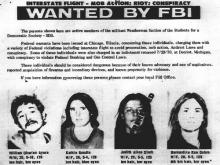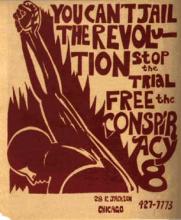Today's young people get a lot of flack for not being politically active enough. Our generation uses Facebook instead of marches, Twitter instead of sit-ins. While it would be nice if this generation initiated more physical grassroots movements (i.e. left the house…), I doubt many would be as radical as the Weathermen during the 1960’s and 1970’s. The politically heated atmosphere of the United States at this time converged with Weathermen ideology causing this extreme left group to attempt to overthrow the U.S. government with bombings and riots.
In the United States in the late 1960’s, radical civil rights groups like the Black Panthers as well as resistance to the U.S. involvement in the Vietnam War heated the political climate. The Weathermen were created as a union between a fragment of the Students for a Democratic Society, a group that tried to activate students to participate in government, and the Progressive Labor Party. Much of the Weathermen's ideology was based on radical civil rights reform and opposition to the war in Vietnam.
The name Weathermen comes from a Bob Dylan song with the lyrics “You don’t need a weatherman to know which way the wind blows.” In their founding document, the Weathermen said that the biggest thing they were fighting against was U.S. imperialism, which, following Lenin’s teachings, said that the poor and oppressed are the creators of an empire’s wealth. They declared their intention to destroy U.S. imperialism and create a world communism.
However, their methods for protest were completely different from the peaceful ideologies of their white compatriots. One of their first actions was called the “Four Days of Rage,” held in 1969 in Chicago. The Chicago police had recently beaten demonstrators who were part of the Chicago Seven (the group that was slammed with riot and conspiracy charges during the 1968 Democratic National Convention). The Weathermen planned for thousands of rioters, but only hundreds showed up.
After this first riot, the group met in 1969 in Flint, Michigan and held what they called the “War Council”. At it, the group declared that they would try and change the world with violent revolution and decided to go underground. They started practicing karate, singing songs, exercising and condemning the pacificism of white middle-class people (like themselves).
After the War Council, the group only became more militant. In February 1970, Weathermen planted a nail bomb in the San Francisco Police Department. It killed one officer and partially blinded another. In the same month, the group aimed to punish the judge who was presiding over the trial of the “Panther 21,” a faction of the Black Panthers who planned bombings in New York City. The Weathermen threw Molotov cocktails into the New York State Supreme Court Justice Murtagh’s home. The group went on to bomb a Greenwich Village townhouse in March.
In May of 1970, Weathermen issued a "Declaration of War" against the United States government in response to the death of Black Panther Fred Hampton during a police raid. They went on to bomb a Police Station in New York City with ten sticks of dynamite, broke an acid leader named Timothy Leary out of prison and sent him to live in Algeria, and bombed a women’s bathroom in the Pentagon in 1972 in protest of the U.S. bombing of Hanoi.
The Weathermen were prosecuted intermittently throughout their attacks, but it was often difficult for police to link the Weathermen to their crimes. In 1970, Detroit indicted 13 Weathermen members on conspiracy to bomb and kill and in October of the same year, member Bernardine Dohrn was put on the FBI’s Most Wanted List.
The group began disintegrating by 1976 when factions in different parts of the country disagreed on the kind of action their groups wanted to take. In addition, black and Hispanic groups said that the Weathermen were taking some of their power.
Today, most Weathermen have re-acclimated into society and have enacted change through less violent means.
Sources and further reading:

